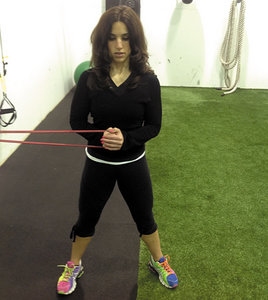Many people become injured because of instability, weakness and poor neural-sequencing patterns in the core. Lack of bracing and support from the inner core cylinder during coronal and transverse movements makes the body vulnerable to compensation injuries.
People sit, walk, run, exercise and move in the sagittal plane far too often. Yet how many patients state their mechanism of injury involved flexion, rotation or side-bending? Reaching for your keys and blowing out your back is an example. Many of our examinations and evaluations are done in the sagittal plane in a loaded, standing position (flexion / extension) and unloaded lying on a table. Evaluating strength and sequencing in the coronal and transverse plane is an extremely effective way of discovering underlying weaknesses in the core sling system of movement patterning.
How can one do this with symptomatic and symptomatic patients? Enter the Pallof press using resistance bands. The Pallof press is named after physical therapist John Pallof, who pioneered the movement.
What make this exercise so beneficial as an assessment? According to personal trainer and certified strength and conditioning specialist, Tony Gentilcore, it evaluates the core from the perspective of what it's designed for, which is not performing sit-ups and crunches: "The core is more of a cross-hatched web (as noted by Mike Robertson), and its main functions (at least in the context of what most people consider encompasses the core – RA, external / internal obliques, etc.) are resisting trunk extension, posterior pelvic tilt, and transmission of hoop stress (rotary or anti-rotation)."
 As such, the Pallof press meets all these criteria, which makes it a versatile evaluation and exercise for almost all your patients. It encompasses the anterior and posterior oblique subsystems of movement and ties in the lateral subsystem from the inside (medial) stance leg. You get activation of the gluteus maximus, which is an essential part of core support. The core is not just above the waist. There are many variations of the Pallof press: tall kneeling, half kneeling, supine, overhead, flexion, extension, etc. However, this article will break down the standard athletic-stance press.
As such, the Pallof press meets all these criteria, which makes it a versatile evaluation and exercise for almost all your patients. It encompasses the anterior and posterior oblique subsystems of movement and ties in the lateral subsystem from the inside (medial) stance leg. You get activation of the gluteus maximus, which is an essential part of core support. The core is not just above the waist. There are many variations of the Pallof press: tall kneeling, half kneeling, supine, overhead, flexion, extension, etc. However, this article will break down the standard athletic-stance press.
Basic Performance of This Movement
- Anchor a resistance band in line with the mid-torso. Grab band with overlapped hands and step away from the anchor point to a tension point based on the variable resistance band you are using and comfort level of the patient. Do not make it too difficult. You are looking for a neural lock and sequencing process. The patient will feel a difference from one side to the other if there is an asymmetry or weakness. (More on that later.)
- Assume an athletic stance: feet shoulder-width apart, chest out, shoulders back. The patient should start the movement with the band held at approximately sternum height. Extend the arms completely, pause for a 5-second count; then return to the starting position.
- Repeat on the other side. Stand the other way and change the inside leg. Hold for 5 seconds.
Things to Watch For
Breath holding. This is a sure sign of poor core stability. The patient will hold their breath to brace IAP (intra-abdominal pressure). This should not occur with such a light load on the body and is a sign of poor core stability. Have the patient exhale on press out and breathe normally in and out through the nose during the 5-second hold. Ask the patient if they had more difficulty breathing on one side compared to the other. The more difficult side is the dysfunctional side. If you find this, you should manually release the diaphragm and teach proper breathing.
Shoulders hike up into the ears. Common cheat to use the upper traps for lack of strength in the core. This calls for possible strengthening in the latissimus dorsi and mid / lower trap.
Pushing their center of gravity too far forward (hips are forward). Look for pelvic tilt.
Why the Pallof Press Is a Powerful Assessment Tool
|
Oblique weakness / inhibition. The obliques flex, rotate and side bend. For example: If standing with left leg toward the anchor point, patient extends arms. This is pulling them into left thoracic spine rotation. So, they must use their right internal oblique and left external oblique to twist the torso to the right. If there's an asymmetry, you are dealing with a spiral-line rotational fascial disconnect. Oblique correctives is a must.
Embracing Active Care
The beautiful thing about this assessment is that it's also the corrective. Regress the movement by stepping closer to the anchor point or lessening the band tension by changing the band color (tension). Do 8-10 repetitions of 1-2-second holds per side. Patients love this exercise because it makes them "feel their abs." When they become stronger, it's noticeable and applicable to daily functional activities.
Moving beyond passive care to active care is the goal we should strive for with our patients. Teach them how to move better to feel better. The Pallof press will be one of your "go to" movements to accomplish this goal.
Resources
- Gentilcore T. "Everything Pallof Press." Blog posting: www.tonygentilcore.com.
- Weinstock D. NeuroKinetic Therapy: An Innovative Approach to Manual Muscle Testing. Berkeley, CA: North Atlantic, 2010.
- Cook G. Movement: Functional Movement Systems: Screening, Assessment, and Corrective Strategies. Aptos, CA: On Target Publications, 2010.
- Vleeming A. Movement, Stability, and Low Back Pain: The Essential Role of the Pelvis. New York: Churchill Livingstone, 1997.
Click here for more information about Perry Nickelston, DC, FMS, SFMA.





